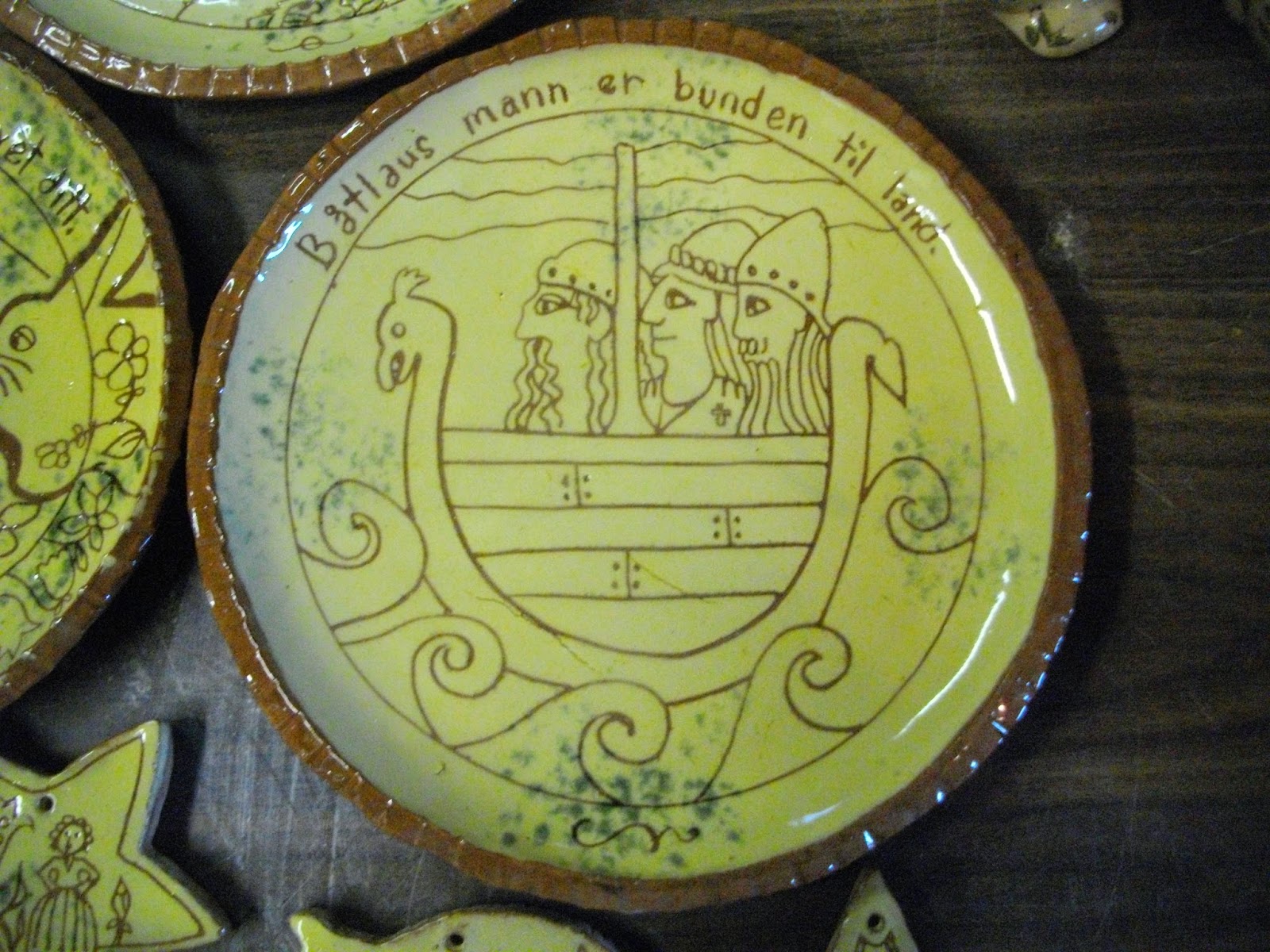Sunday, May 3, 2015
Sgraffito... Norwegian style
I am soon off to the Mid-western part of the USA to demonstrate and teach Early American Pottery for 3 months. I specialize in Yellow Ware, but this is hard to do on the road, as I need a lathe to decorate the feathering patterns, that would be too much to cart around. So I work a lot in miniature and demonstrate pottery by small "samples". I especially like tiny face jugs as my fair-goers do.
The mid-west in the 1800s, was populated by a lot of Scandinavians and Germans. The Germans have kept a low profile due to the wars going on in Europe in the early 1900s. My own great grandfather came from Germany to New York City in the late 1800s. And it was the Germans who brought over the Sgraffito style of pottery to the USA.
Sgraffito is an old style of pottery decoration. It developed in several places in Europe at the same time. In the 1600s, potters all over Europe began to decorate their simple utilitarian clay pot with colored clays called slips. Clay comes in shades of red, yellow and white, but it can also be colored by adding oxides. Cobalt will create shades of blue, chrome shades of green. Their were several ways to decorate with these colors. Slip can be painted and "trailed" onto wares with a quill cup, applied with a sponge or a coat of color applied and decorations scratched through this top layer of color to show the clay color underneath... Sgraffito.
Germans coming to America in the 1600s brought trailing and sgraffito styles. They settled in Pennsylvania and many of our antique sgraffito pots can be traced to that area. Here in New England... not so much. New England was settled early by the English and although the English did sgraffito work back in England in the 1600s, they did little work in sgraffito here. You can find many trailed patterns from early New England. Our own local potter, Hervey Brooks from Goshen CT, did some slip trailed plates. Along the Connecticut shore, potters decorated with slips having the influence of those New York city immigrants nearby.
Midwesterners however, got a late start. Immigrants brought some pottery with them as they settled out west, but by the mid 1800s, pottery was taking a major turn. Our roads were improving and the railroad was being laid out connecting all parts of the country by an effective means of transporting clay and the finished pottery.
Industrialization. Now potters built factories and hired unskilled labor to mass produce pottery. Those simple red clay pots were replaced by china dishes and stoneware crocks. The small potters careers were basically over.
Joseph Pohl came to Minnesota in the 1860s and made red ware pots from the clay on his property. He used a simple treadle wheel and sold his utilitarian bake ware and flower pots to the locals. But less than 10 years later, Red Wing pottery opened its major operation nearby. They would manufacture thousands of crocks and dishes.
So the art of Sgraffito stayed mostly in Pennsylvania where it is still made and sought after today.
I am working out some classes in Minnesota. I would like to bring to the German and Scandinavian descendant's any other nationality, the wonderful art of Sgraffito. The two plates above have my new Norwegian flavor. Red clay is rolled out and placed over a plaster bat to firm up. In the "old" days, white clay slip would be applied to the plate, the design scratched into the white to expose the red clay underneath and a coating of lead glazed applied. When fired in the kiln, the lead and oxides in the clay would turn the white slip to a lovely yellow. Nowadays, we can use lead free glazes, but we must tint the white clay yellow with oxides to replicate the old wares. A dab of copper green is applied for variation.
The Norwegian themes of Vikings, boats and the fairy tale of Billy Goat Gruff and the troll work up nicely.
Students in my class will make up some cookie cutter ornaments to practice the technique. Then they will be working up plates with drawings of their own creation. Below are a couple of other examples. For those who may think they are not artistic, the cookie cutter rabbits (or other shapes) can be traced and embellished to create a pleasing plate.
Anyone wishing to learn more about taking a class in the art of Sgraffito can contact me on this blog or www.eastknollpottery.com
Come and try out a wonderful old style of pottery decoration and create an heirloom for future generations!
Subscribe to:
Post Comments (Atom)








No comments:
Post a Comment